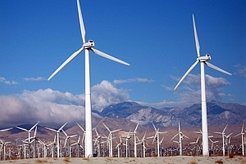Large wind farms expected to slow down winds and yield less energy
Renewable wind energy sees a tremendous growth with more and more wind turbines being installed across landscapes. But what happens to the wind when a larger number of wind turbines removes more and more of the energy from atmospheric motion?

The researchers used a highly sophisticated simulation model routinely used in weather forecasting in which wind farms and their effects were incorporated and applied it to the central United States, one of the windiest regions on land. Dr. Lee Miller, lead author and scientist at the Max-Planck-Institute for Biogeochemistry in Jena, describes: “When we considered only a few turbines, we found what we expected, that more turbines generate more electricity. But when we considered more and more turbines, we found that wind speeds decreased and each turbine generated less energy.” This slowdown in winds resulted in a maximum in wind energy of about 1 Watt per square meter that can at most be generated within the region, which is far less than what was previously estimated for the same region without accounting for the slowdown effect.
Dr. Axel Kleidon, group leader at the Max Planck Institute for Biogeochemistry, explains that these low limits for wind energy can be understood by physics: “The atmosphere supplies the energy to sustain winds at the surface at a low rate. The more wind turbines remove this energy, wind speeds need to slow down. The combination of the two effects result in the low limit for large wind farms.”
Kleidon also agrees that current wind farms are likely operating well below this limit. Yet he ar-gues that this limit will become important for the future transition to renewable energy when more and more wind turbines are being installed. In comparison to other forms of renewable energy, he also points out that such slowdown effects do not apply to solar energy, so that more solar panels yield proportionally more solar power.
The study is published online in the scientific journal Proceedings of the National Academy of Sciences on August 24th, 2015.
